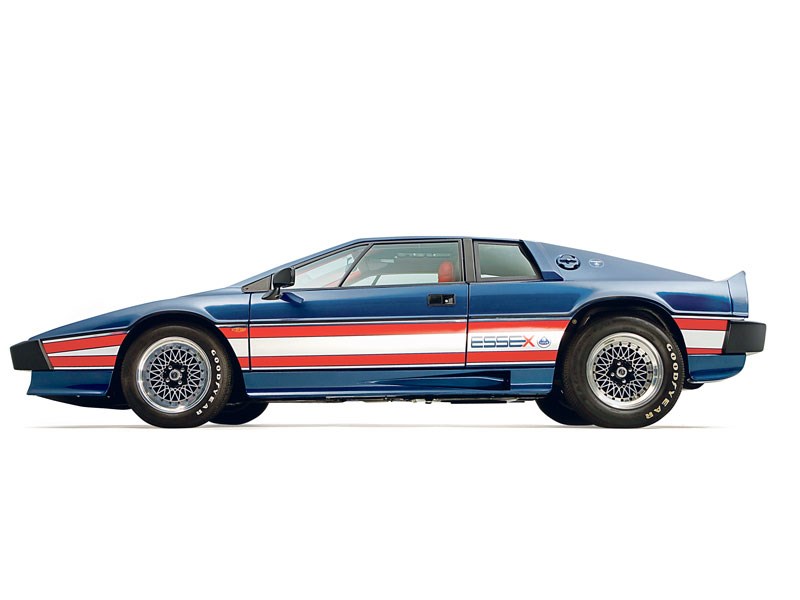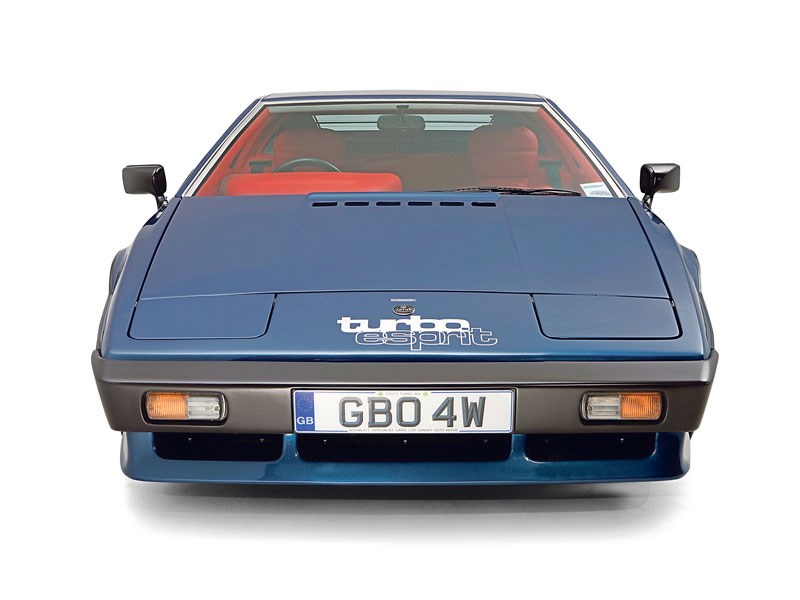For anyone over 6ft tall, the Esprit’s cabin is quite a tight squeeze and the fore/aft seat adjustment is limited by the engine firewall. But once you acclimatise, it’s the grip that amazes. The limits of the Esprit’s adhesion are so high that if the rear does slide, you’ll need good reflexes to catch it, as you’ll be doing silly speeds. With well-judged suspension and responsive steering, it’s a proper driver’s car. The 907 engine is flexible and tractable, pulls beautifully and is well mannered once the carbs have warmed up. As an everyday car, its lack of practicality would annoy, but as a weekend car it’s a joy.
It may be a two-seater, but unlike some sports cars, the Esprit provides plenty of space inside its cosy cabin, with a plunging dashboard, bucket seats and high transmission tunnel resulting in a luxurious cabin that totally envelops passengers.
Lotus’ focus has always been more on handling than straight-line speed, and the Esprit conforms to its benchmark standards of manoeuvrability. With its light weight, ground-hugging profile and mid-mounted engine, the Esprit is an utter treat on twisty roads – you’ll lose confidence long before the car will lose grip, although if you do get silly, an Esprit can break away in a shockingly scary way. That balanced, flickable ability on bends means you can forgive it not actually being that fast, unless you’re in a Turbo, in which case all the essential supercar elements are in place. The Esprit does share one of the major foibles of mid-engined supercars however – rearward visibility is far from great. It’s a nightmare to park.
VITAL STATISTICS
Lotus Esprit S1
Engine 1973cc/4-cyl/DOHC
Power (bhp@rpm) 160bhp@6200rpm
Torque (lb ft@rpm) 140lb ft@ 4900rpm
Top speed 124mph
0-60mph 8.4sec
Consumption 23mpg
Gearbox 5-spd manual
WHAT TO LOOK FOR
BODYWORK & CHASSIS
Body corrosion isn’t an issue, thanks to glassfibre construction, and the shell is pretty resilient. The nose is prone to stone chips and the entire body should be checked for star cracks and signs of accident damage repair, most likely in the corners.
You’ll need to get under the car to check the chassis for corrosion, likely to occur around the insulating (and water-absorbing) layer of felt between the chassis and the body. From May 1980, a galvanised chassis was adopted.
ENGINE
Three engines were used – the Type 907 (2.0-litre), 912 (2.2-litre) and 910 (2.2-litre with a whopping great turbocharger attached). The engines have a reputation for fragility, so look for evidence of their 6000-mile/six-month service intervals using a genuine anti-drain valve Lotus oil filter fitted. Listen for big end rumblings when the engine is started – a sign of oil starvation if a Lotus filter hasn’t been used. Oil pressure should show 35psi at 3500rpm to 45psi at 6500rpm, although at idle it can drop as low as 5psi. Cambelts need to be changed every 24,000 miles or two years. On turbo cars, the wastegate can seize – so you won’t hear that distinctive ‘pssssst’ and the boost pressure gauge won’t climb above 0.8bar.
RUNNING GEAR
Gearboxes are from the Citroën SM, and finding parts is like looking for a mechanical needle in an automotive haystack. So ensure on your test drive that the changes are slick and smooth; worn cables and bushes will make them difficult. Listen for whining too – a sign of bearings past their best. If the clutch has recently been renewed, ask if the spigot bearing was done at the same time; it needs to be lubricated, and if it isn’t, it can fail and junk the crankshaft at the same time.
Heavy steering points to a worn out steering rack, with S3 models most likely to suffer from this, due to wider wheels. At best, you’ll probably see 48,000 miles from a rack. Also check the steering self-centres – if it doesn’t, the universal joint on the column has likely seized, although this is quite cheap to replace. Clonks while accelerating and decelerating point to suspension universal joints past their best, and bearings also wear quite frequently as well. On post-1985 cars, a Toyota front suspension set-up was used, which is much better than the previous system with trunnions requiring regular lubrication. Look around the anti-roll bar mountings on all cars, though – the lower wishbones can crack in this area.
BRAKES
Test the handbrake – it seizes easily because it can’t be lubricated. The lever itself can even break away on S1/2 cars because it gets knocked easily. The mounting was strengthened on S3 cars. Do check the plastic clutch slave cylinder pipe – it goes brittle, and can spill fluid over the rear brakes, which can then catch fire and burn out the whole car. Braided upgrades are available.
INTERIOR
Several different upholstery types were used – it’s really only leather you need to check closely, for signs of cracking. The bonded windscreen on S1/2 models tends to leak with age, so look on the dash for signs of water ingress. Electrical problems are often traced back to bad earths, due to the plastic body.
OUR VERDICT
The Esprit started life as a concept car at the 1972 Turin Motor Show, the first of Giorgetto Giugiaro’s ‘folded paper’ designs that forgot curves in favour of finely chiselled lines and angles. And anything that is born as a concept is pretty damn spectacular if it ever escapes into the mainstream.
The Esprit heralded Lotus’ true transformation from kit car specialist to supercar manufacturer, although the first cars, with their Jensen-Healey two-litre engines, did lack the speed and acceleration that one might have expected from such a spectacular looker. As the various series progressed, performance improved, as did Lotus’ attention to build quality, which was initially pretty woeful. However, it was only in 1980, when Lotus strapped on Garrett AiResearch T3 turbochargers onto the engines of limited edition Essex models that what the cars could do finally correlated with the stunning presence. That put top speed up to over 150mph and the 0-60mph to five seconds.
Owning an Esprit isn’t a proposition you enter into lightly. As tempting as it may be to own something with supercar looks for much less than you’d pay for a mainland European equivalent, just be wary that these are high maintenance cars, and unless you’re prepared to do some of the basic jobs yourself, ownership costs can be high. That said, if you’re prepared to open your heart and wallet to an Esprit, it can be an immensely rewarding classic. It is one of the most eye-catching British sports cars ever constructed. Find the right road, where you can exploit the handling prowess, and there’s very little to compare with an Esprit. The word itself stands for ‘liveliness of mind or spirit’ and this is one of those machines that completely fulfils the title bestowed on it.


